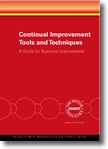 |
The Pareto Principle - The Vital
Few and Trivial Many - The 80/20 Rule
However paraphrased; pareto is a simple management tool
with wide business application. It can provide valuable information, which
allows us to focus on the vital few, rather than the trivial many.
As an example of the basic rule: 80% of customer complaints are caused
by 20% of our products or services and this is where we should concentrate
our improvement efforts.
The 80/20 theory was first developed in 1906, by Italian economist and
sociologist, Vilfredo
Pareto, who observed an unequal distribution of wealth and power in
a relatively small proportion of the total population.
Joseph M. Juran is credited with adapting Pareto's economic observations
to business applications and in 1950; he published "The Quality Control
Handbook," which first recognised the applicability of the Pareto
principle in the context of inventory management. As a credit to Pareto's
work, Juran named his finding 'The Pareto Principle'.
How to - Pareto
Chart
The guide includes an overview of pareto charts,
when to use them, how to use them, how to interpret results; as well as
exercises for getting started...
The
US Navy Total Quality Leadership Office
|
A Guide for Business Improvement
|
|


View larger image |
This guide explains how to carry out
more than twenty tools & techniques necessary to ensure your
business continually improves.
Topics covered include:
Affinity diagrams, Bar charts, Black & white charts, Brainstorming,
Cause & effect diagrams, Design of Experiments (DoE), Failure
Mode, Effect and Criticality Analysis (FMEA/FMECA), Fault Tree Analysis
(FTA), Five WHY’s for root cause analysis, Five Ws & one
H for problem definition, Flow charting, Histograms, Pareto
analysis, Pictograms, Pie charts, Plan-Do-Check-Act (PDCA)
cycle, Quality Function Deployment (QFD), Rating, Repeatability
and Reproducibility tests (R&R), Run charts, Significance testing,
Solution effect diagrams
Also includes a handy matrix showing when to apply which tool &
technique. |
| |
| Further reading |

|
The Memory
Jogger II: A Pocket Guide of Tools for Continuous Improvement
Michael Brassard |
| This
handy Pocket Guide uses graphics and easy-to-understand text to
describe what the tools are, why they’re used, and how to
use them. Tools are explained using real-life examples from all
types of organisations, making them easy for everyone to understand
and apply. The 22 Tools covered are
Activity Network Diagram, Affinity Diagram, Brainstorming, Cause
& Effect (Fishbone), Check Sheets, Control Charts, Data Points,
Flowchart, Force Field Analysis, Histograms, Interrelationship Digraph
(ID), Matrix Diagram, Multivoting, Pareto Chart, Prioritization
Matrices, Problem Solving Model, Process Capability, Radar Chart,
Run Chart, Scatter Diagram, Team Guidelines, Tree Diagram, Process
Decision, Program Chart, Nominal Group Technique (NGT).
|
| Buy
UK |
Buy
US |
|
Links
Arthur
Hafner
For a straightforward overview of the 80/20 rule, visit the site of Arthur
Hafner, Professor and Dean of University Libraries in the US. Arthur provides
an excellent insight into the 80/20 rule as well as several examples where
the rule applies...
The
University of Melbourne Department of Economics
Biography of Vilfredo Pareto with links to other resources...
United
States Department of Energy Handford Site
Excellent overview of Pareto Charts with a good and bad example...

top of page |
 |
